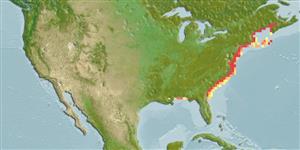Common names from other countries
Classification / Names / Names
Namen | Synonyme | Catalog of Fishes (gen., sp.) | ITIS | CoL | WoRMS
Environment: milieu / climate zone / depth range / distribution range
Ökologie
; tiefenbereich 0 - 36 m (Ref. 83435). Subtropical, preferred 17°C (Ref. 107945); 49°N - 30°N, 80°E - 65°W (Ref. 83435)
Atlantic and the Mediterranean.
Length at first maturity / Size / Gewicht / Alter
Maturity: Lm ? range ? - ? cm Max length : 13.0 cm TL Männchen/unbestimmt; (Ref. 7726); max. veröff. Alter: 9 Jahre (Ref. 2823)
Maximum depth from Ref. 104365. Found buried in muddy sediment on the lower shore and shallow sublittoral and in bays and estuaries. Prefers sandy environments to depths of 15 m (Ref. 78574).
Life cycle and mating behavior
Geschlechtsreife | Fortpflanzung | Ablaichen | Eier | Fecundity | Larven
Members of the class Bivalvia are mostly gonochoric, some are protandric hermaphrodites. Life cycle: Embryos develop into free-swimming trocophore larvae, succeeded by the bivalve veliger, resembling a miniature clam.
Harvey-Clark, C. 1997. (Ref. 7726)
IUCN Rote Liste Status (Ref. 130435)
CITES Status (Ref. 108899)
Not Evaluated
Not Evaluated
Nutzung durch Menschen
Fischereien: kommerziell
FAO - Aquakultur: production, Artbeschreibung; Fischereien: landings, Artbeschreibung | FishSource | Sea Around Us
Tools
Internet Quellen
Estimates based on models
Preferred temperature
(Ref.
115969): 8.8 - 23.7, mean 13.2 (based on 120 cells).
Widerstandsfähigkeit
hoch, Verdopplung der Population dauert weniger als 15 Monate. (K=0.16-0.5; tmax=9).
Prior r = 0.43, 95% CL = 0.28 - 0.65, Based on 3 data-limited stock assessments.
Verwundbarkeit
Low to moderate vulnerability (25 of 100).
